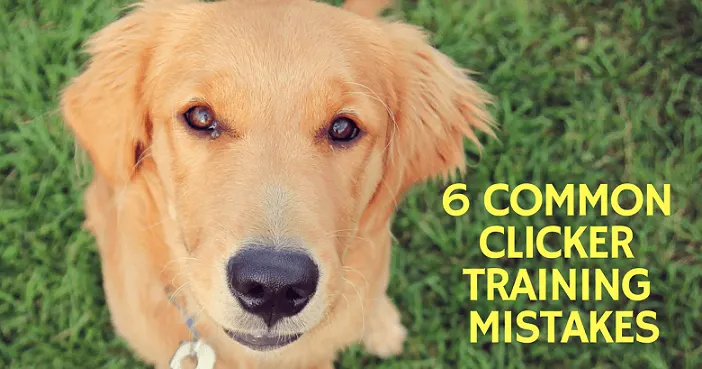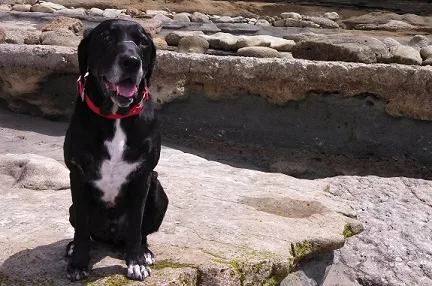I do not do a lot of clicker training myself, but I recognize its benefits.
I also know many of you prefer clicker training to other training methods or would at least like to learn more about it. (Clicker training works well with my cat Beamer!)
I reached out to two professional dog trainers and asked them about some of the most common mistakes or misunderstandings they see when it comes to clicker training a dog.
If the rest of you have any additional mistakes or ideas to add to the list, please do so in the comments.
If you’d like to order a clicker, check out Mighty Paw’s clicker here.
Common clicker training mistakes

Mistake #1 – Using the clicker as an attention-getter instead of a marker.
One mistake people make when clicker training is using the clicker to get a dog’s attention instead of using it to mark a behavior, said Jennifer Mauger, a professional dog trainer with L’Chaim Canine.
“They click when they want the dog to come to them or when the dog is distracted,” she said. “This defeats the purpose of the clicker. It should be used as an event marker. It marks the moment the dog is performing the correct behavior.”
Mistake #2 – Poor treat delivery.
While you want to use a treat to reinforce the click, you shouldn’t move your “treat hand” until after the click, said dog trainer Beth Mullen with Dog Latin Dog Training.
You don’t want the dog to be focused on your “treat hand.” You want him to be thinking about what gets him the click.
“Click, pause, then move your hand,” she said.
Another issue is that some dog owners will automatically point the clickers at their dogs like a remote, Mullen said. It’s better to hold the clicker at your side.
Mistake #3 – Assuming the dog is food motivated.
“For some dogs, food is not a big motivator,” Mauger said. In those cases, you should pair the clicker with what does motivate the dog such as a toy.
“I have worked with a couple of German shepherds and border collies that were far more motivated by a ball than food,” she said.
Hmm, I think I know a dog like that! 🙂
Now, let’s move on to some of the most common misunderstandings about clicker training. Again, feel free to add your own ideas to the list in the comments.
*Enjoying this article? Get realistic dog training tips emailed once a week. Click Here
Common clicker training misunderstandings
Misunderstanding #1 – All those treats will make your dog fat.
Obviously when you’re using lots of treats or other food for training you need to factor that into your dog’s daily calories.
Mullen made the point that eating out of a bowl is not necessary for dogs. It’s convenient for humans. She said it’s OK to use some of your dog’s food throughout the day to strengthen the behaviors you want.
Misunderstanding #2 – Clicker training is only for ‘easy’ dogs.
Clicker training is used for all kinds of dogs, Mauger said. It’s a concept used by some professionals to work with dogs with severe behavioral problems such as aggression or separation anxiety.
She said people don’t always realize clicker training is based on sound science. It’s not some sort of “gimmick.”

Misunderstanding #3 – Clicker training is only for teaching tricks.
Sure, clicker training can be used for tricks, but it’s also used to train high-level military, police, search & rescue and service dogs, Mauger said.
Mullen said clicker training is also being used to teach marine mammals, zoo animals and more.
“So many wonderful, successful animal trainers use marker training,” she said.
What are some other clicker training mistakes or misconceptions?
Let me know in the comments!
*Enjoying this article? Get realistic dog training tips emailed once a week. Click Here
Related posts:
What dog training mistakes have you made?
Lindsay Stordahl is the founder of That Mutt. She writes about dog training, dog exercise and feeding a healthy raw diet.

Lisa
Monday 6th of February 2017
I like the clicker because I find that I'm inconsistent with my verbal cues. My trainer recommends saying something like "Yes!" or "Good!" when your dog has done whatever it is you're asking AND giving the treat immediately. I have a hard time saying the same word/s the same way each time and then I'm not fast enough with the treat. The clicker is really helpful for marking the correct behavior as soon as it happens and then giving a treat.
It's also really useful if I'm using the treat as a lure to get my dog into position. The clicker allows me to hold the treat under my dogs nose and draw her into the right spot/pose and then the click really signals "You've done this just right!".
Lindsay Stordahl
Monday 6th of February 2017
yes, those are all good points!
BoingyDog
Wednesday 7th of May 2014
This is great! I love using clickers with younger dogs. I'm having fun using with a puppy I'm working with! It certainly takes skill and coordination but can be so much fun for the dog!
Lindsay Stordahl
Wednesday 7th of May 2014
I think so too :)
Linda
Saturday 3rd of May 2014
I sometimes get the timing of the actual click wrong - and click too late. That's obviously not very helpful for Alfie who won't understand what I want him to do :-)
Chris Fowler
Saturday 3rd of May 2014
I think this is a great topic Lindsay, I like the way you present ideas for discussion, with an open mind, so refreshing in the dog world. I studied Clicker Training with Karen Pryor Clicker Training Academy, and I must admit upfront, I am a drop out! I am not an advocate of clicker training, nor am I opposed. I think it has a place, especially if one is trying to train a specific 'trick'. Clicker Training is simply Operant Conditioning, it will work on almost any living creature. But, here's the thing, dogs aren't fish, or chickens. Dogs are a unique animal that has evolved to work with humans. Dogs relate to humans on a completely different level. So when it comes to behavioral issues, I find clicker training to be rather useless. That is why I am a KPCTA drop out, I wanted to understand why dogs do what they do, not train fish to jump thru hoops. Unfortunately, I still haven't found the answer to my question. I have studied quite a few theories, just not many that seem to ring true. Thanks again for another interesting topic.
Michelle Benson
Monday 29th of August 2016
Ian Dunbar has written some good books with research to back up "Why Dogs Do What They Do." He has a website called dogstardaily.com. You may have already heard of him but if not, check him out.
Lindsay Stordahl
Saturday 3rd of May 2014
It's certainly not for everyone. So thanks for your honest opinion. I like clicker training and think it's a lot of fun, but I usually fall back to just rewarding my dog with treats and praise for what I want while blocking the behaviors I don't want. I don't "mark" the behavior I'm looking for.
Clicker training requires me to think differently about how I'm used to training dogs though, and I see that as a good thing because it forces me to be more creative and open minded.
I think it's great you gave it a try and also that you realized it's just not for you.
weliveinaflat
Saturday 3rd of May 2014
love this article... definitely some great tips and correcting misconceptions :)